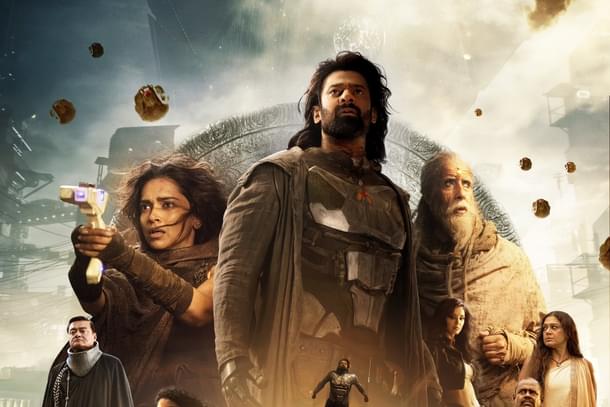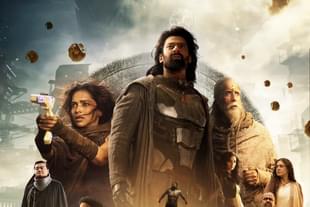Movies
Kalki 2898 AD: Mythology Meets Mediocrity — Movie Review
Aravindan Neelakandan
Jul 01, 2024, 04:13 PM | Updated Jul 02, 2024, 08:30 AM IST
Save & read from anywhere!
Bookmark stories for easy access on any device or the Swarajya app.


‘Kalki 2898 AD’ is considered perhaps the most ambitious science fiction-fantasy movie ever made in the Indian film industry and rightly so.
Elite dictatorship in a dystopian future with rebels fighting against the technologically superior powerful tyranny of the elite is a hyper-used cliche in Hollywood. This movie also uses that theme incorporating Hindu mythological elements as an overlay — specifically from Mahabharata and also the coming of Kalki in Kali Yuga.
The movie uses the legendary figure of Aśvatthāma — son of Drona cursed with immortality and eternal wandering as the key character. The story is told in a gripping manner as much as possible. There are significant successes and there is an overall failure.
The movie lacks a single grand high catharsis moment. It does not lead the viewers towards a grand finale and then a suspense-filled possibility of part two, as the director clearly intends. Instead, the director has wanted to incorporate every grand unfolding scene in every Hollywood success movie into ‘Kalki.’ The result is that the special effects have a strong diminishing marginal utility on the viewers.
Consider, for example, ‘Close Encounters of the Third Kind’ (1977). There were special effects. Each element, like notes in an orchestral crescendo, converges seamlessly toward the climactic revelation- the iconic arrival of the mother ship.
Or take ‘Avatar’ (2009). Here the director has very clearly used the theme of the Mother Tree of Avatar. But while in ‘Avatar’ it merges with the context and becomes a powerful symbol, here it is a mere inconsequential presence.
Even the character development owes it to Hollywood rather than to the Hindu psychological universe. Consider the character of Bounty Hunter ‘Bhairava.’ He is clearly adapted from Han Solo of Star Wars (1977) — played by Harrison Ford. He was self-serving and had no ethical problems whatsoever.
Even the AI friend who comes in Kalki reminds one of R2D2 and C3PO. Then you have a strong visible imprint of the Mad Max series in the movie. One cannot help but compare Shambala of Kalki with Zion of Matrix (1999).
When the forces of the ‘Complex’ invade and attack ‘Shambala’, the scene is very much an imitation of the scene of Voldemort and his army attacking Hogwarts in ‘Harry Potter and the Deathly Hallows: Part 2’ (2011). Even the theme of the search for fertile women in Dystopia has a distant echo in ‘2019: After the Fall of New York’ (directed by Sergio Martino), a 1983 Italian movie dubbed in English and released worldwide. Even the lasso of truth of Wonder Woman makes a brief appearance.
So, what is exactly Indian about the movie? It is hard to tell. Perhaps this introduces our epics and Puranic concepts to modern youth? The viewers can decide. Even the idea of a God-human who is the supremo of Complex strongly against a God reincarnating, the way it is presented in the movie, moves closer to the Devil-God binary than the Asura-Deva binary. The former is an irreversible distinct category. The latter is a mutable interlinked binary with grey areas.
The performance of Amitabh Bachchan, more digitally generated than real, nevertheless invigorates the movie. It is indeed the saving grace. Deepika Padukone is more doll-like than life-like. Shobana acts with all her being as ever, But, alas, her character, though with a lot of scope, was made too little to contain her skills. Yet even in that limited scope, she delivers a performance as good as possible. The character of Bhairava is too flat, unidimensional and cliched. Ace comedian Brahmanandam is more wasted than utilised.
Glorification of Karna over Arjuna is a deep problem that the modern Indian psyche suffers from. It is a symptom of a shallow understanding of the epic and an entire misunderstanding of Dharma. Makers of this movie are no exception. But with the Bhairava symbolic name and Karna identity dangling as two separate threads, it creates more disharmony than adding a complex beauty to the plot.
One wishes they had developed the plot with more conversations, more in-depth yet engaging discussions, a thoughtful and well-designed intelligent unfolding of special effects unveiling a plot leading to a crescendo and more an Indian epic rather than a Western plot adapted with Indian exterior in a half-baked manner.
On the whole, the movie is a three-hour of entertaining disappointment. On the positive side, the movie proves that we can imitate Hollywood special effects with near perfection. Now it is time for us to find our own story and tell it in our own manner with our own conception of special effects.





